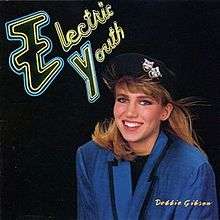Electric Youth (album)
Electric Youth is the second album by American singer-songwriter Debbie Gibson, released January 24, 1989 on Atlantic Records. It is the highest-charting album of Gibson's career, staying at the top of the US Billboard 200 albums chart for five weeks, and reaching number 8 on the UK Albums Chart.
| Electric Youth | ||||
|---|---|---|---|---|
 | ||||
| Studio album by | ||||
| Released | January 24, 1989 | |||
| Recorded | 1988 | |||
| Studio | Z Studio, Brooklyn, Sorcerer Sound, The Hit Factory, and Soundtrack, New York City | |||
| Genre | ||||
| Length | 58:17 | |||
| Label | Atlantic | |||
| Producer | ||||
| Debbie Gibson chronology | ||||
| ||||
| Singles from Electric Youth | ||||
| ||||
| Review scores | |
|---|---|
| Source | Rating |
| AllMusic | |
| Rolling Stone | |
| Robert Christgau | (C+)[3] |
Composition
As with her debut album, Out of the Blue, all tracks were written by Gibson, and she single-handedly produced six of the tracks. She was also given half of the production credits on one track alongside Fred Zarr who produced the other four tracks. The album, like her first, contains mainly bubblegum-pop songs, though other, more mature styles are touched upon.
Singles
Electric Youth spawned four singles, the first being the biggest charting single of her career—"Lost in Your Eyes," which held #1 on the Billboard Hot 100 for 3 weeks. "Electric Youth", the album's title track, just missed the Top 10, reaching #11. "No More Rhyme" followed, ending its run at #17, and "We Could Be Together" charted at #71.
Commercial success
In the US, the album was certified 2x Platinum by the RIAA and sold over 4 million copies worldwide.[4] Gibson promoted the album with "The Electric Youth World Tour" in 1989. In parallel with the album, she created an Electric Youth perfume under Revlon, and various makeup essentials for young girls through Natural Wonder Cosmetics, one of her sponsors at the time, distributed throughout the US.
The album also inspired an original stage musical of the same name which premiered at the Starlight Dinner Theatre (formerly Mark Two Dinner Theatre) in Orlando, Florida. Dean Parker wrote the book and Gibson co-produced.
Track listing
All songs written by Debbie Gibson. (Music Sales Corporation, ASCAP)
Side One - This Side
- "Who Loves Ya Baby?" (4:00)
- "Lost in Your Eyes" (3:34)
- "Love in Disguise" (4:17)
- "Helplessly in Love" (4:10)
- "Silence Speaks (a Thousand Words)" (3:37)
- "Should've Been the One" (5:07)
Side Two - That Side
- "Electric Youth" (4:55)
- "No More Rhyme" (4:13)
- "Over the Wall" (3:58)
- "We Could Be Together" (5:33)
- "Shades of the Past" (4:52)
CD bonus tracks:
- "We Could Be Together" (Campfire Mix) (5:33)*
- "No More Rhyme" (Acoustic Mix) (4:13)*
Charts and certifications
Weekly charts
|
Certifications and sales
| |||||||||||||||||||||||||||||||||||||||||||||||||||||||||
Personnel
|
Musicians
|
Production
|
References
- Buss, Bryan. "Debbie Gibson -Electric Youth | Overview". AllMusic. All Media Network. Archived from the original on October 9, 2012. Retrieved February 24, 2016.
- Coleman, Mark (April 6, 1989). "Debbie Gibson - Out of the Blue | Rolling Stone Review". Rolling Stone. Jann Wenner. Archived from the original on November 19, 2008. Retrieved February 24, 2016.
- "Robert Christgau: CG: Debbie Gibson - Out of the Blue". robertchristgau.com. Archived from the original on 24 February 2016. Retrieved 24 February 2016.
- Truest, Dick (August 11, 1989). "Next, try Debbie Gibson, movie star". Milwaukee Journal Sentinel. Elizabeth Brenner. Retrieved February 28, 2016.
- "Debbie Gibson - Out of the Blue | Australian Charts". www.australian-charts.com. Archived from the original on November 11, 2012. Retrieved February 24, 2016.
- "Top Albums/CDs - Volume 50, No. 1 May 1, 1989". 2013-07-17. Archived from the original on July 19, 2016. Retrieved 2017-05-21.CS1 maint: BOT: original-url status unknown (link). RPM (magazine).
- "Album – Electric Youth". Media Control Charts. Retrieved 2011-10-17.
- "Debbie Gibson – Out of the Blue". Missing or empty
|url=(help) - "Debbie Gibson – Electric Youth". charts.nz. Hung Medien. Retrieved February 24, 2016.
- "Debbie Gibson – Electric Youth". swedishcharts.com. Hung Medien. Archived from the original on April 12, 2014. Retrieved February 24, 2016.
- "Debbie Gibson – Electric Youth (Swiss charts)". swisscharts.com. Hung Medien. Archived from the original on July 1, 2015. Retrieved February 24, 2016.
- UK charts - Debbie Gibson www.officialcharts.com Retrieved February 24, 2016.
- Billboard charts - Debbie Gibson Billboard. Retrieved February 24, 2016.
- "The ARIA Australian Top 100 Albums Chart – 1989 (1–60) (from The ARIA Report Issue No. 1)". Imgur.com (original document published by ARIA). Retrieved May 9, 2017. N.B. The triangle symbol indicates platinum certification.
- "IFPIHK Gold Disc Award − 1990". IFPI Hong Kong.
- "Japanese album certifications – デビー・ギブソン – エレクトリック・ユース" (in Japanese). Recording Industry Association of Japan.
- "British album certifications – Debbie Gibson – Electric Youth". British Phonographic Industry. Select albums in the Format field. Select Gold in the Certification field. Type Electric Youth in the "Search BPI Awards" field and then press Enter.
- "American album certifications – Debbie Gibson – Electric Youth". Recording Industry Association of America. If necessary, click Advanced, then click Format, then select Album, then click SEARCH.